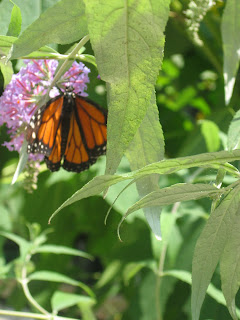I'm in St. Louis for a conference this week. It feels strangely good to be back in the Midwest. I was worried that I hadn't brought nice enough clothing, annoyed that I was all bloated from the long heat wave and high humidity, insecure about my general lack of trendiness and my clothes that I worry scream "Limited Budget!", because that's how I generally feel in DC. Then all the St. Louisans got on the MetroLink to go to the Cardinals game, with their comfort-food Midwestern bodies (not necessarily fat, just normal-looking, not anorexic like on the East Coast) and their lack of being overly concerned about appearance. Then I felt better. Like I was home, back in a place that's much simpler.
The conference just started today, so I had much of the weekend to spend with old friends. Saturday night I got together with a friend from college who just married one of my Chicago friends - a fun merging of two worlds. Among the things we did that night was a trip to Ted Drewes, the best frozen custard place around. It's so good, Alton Brown visited it a few years ago during his "Feasting on Asphalt" series.
Sunday, we took a trip to Columbia, the ol' college town and home of many memories (some of which I'd like to forget), to walk around campus and visit with some other college friends who have had two children and conceived a third in the five years since I was there last. Their kids are great, and they are great parents. If I could be absolutely guaranteed that my children would be like that, I might give more consideration to becoming a parent myself.
Anyway, even after seeing the big changes on campus, around the downtown area, and in my friends' lives, it's nice to know that some things are still the same. I got quite nostalgic, feeling like I was back home where I belonged. My college friends and I joke around in ways that people on the East Coast don't seem comfortable with. Something about Midwestern sensibilities and the openness that comes with growing up in communities where people really get to know each other and talk about the things that really matter. It's too bad that Missouri is "fly-over country" to people on the East Coast, because I think the social and political atmosphere in this country would be different if Midwesterners weren't just seen as hoosiers, rednecks, farmers, or any of the other stereotypes that prevail. Being out here has just further solidified my need to get away from the Beltway. I never thought I'd get burned out on Washington DC, but after two years, it's happened.
The funny thing is, as much as I really love Missouri, I can't see myself moving back here. Why? There are lots of opportunities for outdoor recreation. There are Whole Foods, Trader Joe's, and plenty of other organic/natural food options. According to my friend, there are few farmers' markets, which is puzzling, but not really limiting. There are young people who are professionals, smart, active, interesting. There is art, music, good food, plenty of good beer and wine - all things I enjoy. It's just not in your face like it is in major metropolitan areas. You have to look a little harder, and you have to drive everywhere. Perhaps my biggest concern is that I am a bit of an eco-snob. Yes, I'll admit it. People in Missouri are not necessarily eco-snobs. That kind of culture just isn't prevalent here. I was the silly hippie in my college days, and I'd be the silly hippie again if I moved back. For that reason alone, I was never fully content out here, and I just can't do that again. So, Missouri, I love you dearly and I promise to come visit more often. But I'm sorry, I just can't stay.

